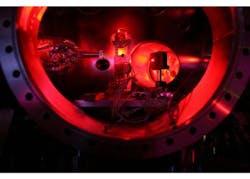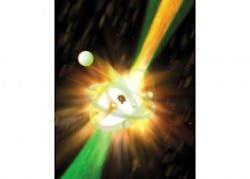SLAC researchers probe two-million-degree matter, create first atomic X-ray laser
Menlo Park, CA--Researchers working at the U.S. Department of Energy's (DOE) SLAC National Accelerator Laboratory have used the world's most powerful X-ray laser to create and probe a two-million-degree piece of matter in a controlled way for the first time. In addition, a different group of researchers collaborating on another SLAC project have created the shortest, purest X-ray laser pulses ever achieved, fulfilling a 45-year-old prediction and opening the door to a new range of scientific discovery.
Probing two-million-degree matter
The ability to probe two-million-degree matter, as reported in Nature, takes scientists a significant step forward in understanding the most extreme matter found in the hearts of stars and giant planets, and could help experiments aimed at recreating the nuclear fusion process that powers the sun.
The experiments were carried out at SLAC's Linac Coherent Light Source (LCLS), whose rapid-fire laser pulses are a billion times brighter than those of any X-ray source before it. Scientists used those pulses to flash-heat a tiny piece of aluminum foil, creating what is known as "hot dense matter," and took the temperature of this solid plasma—about 2 million degrees Celsius. The whole process took less than a trillionth of a second.
"The LCLS X-ray laser is a truly remarkable machine," said Sam Vinko, a postdoctoral researcher at Oxford University and the paper's lead author. "Making extremely hot, dense matter is important scientifically if we are ultimately to understand the conditions that exist inside stars and at the center of giant planets within our own solar system and beyond."
Scientists have long been able to create plasma from gases and study it with conventional lasers, said co-author Bob Nagler of SLAC, an LCLS instrument scientist. But no tools were available for doing the same at solid densities that cannot be penetrated by conventional laser beams.
"The LCLS, with its ultra-short wavelengths of X-ray laser light, is the first that can penetrate a dense solid and create a uniform patch of plasma—in this case a cube one-thousandth of a centimeter on a side—and probe it at the same time," Nagler said.
The resulting measurements, he said, will feed back into theories and computer simulations of how hot, dense matter behaves. This could help scientists analyze and recreate the nuclear fusion process that powers the sun.
The first atomic X-ray laser
SLAC scientists have also created the shortest, purest X-ray laser pulses ever achieved. In the Nature report, the researchers aimed SLAC's LCLS at a capsule of neon gas, setting off an avalanche of X-ray emissions to create the world’s first "atomic X-ray laser."
"X-rays give us a penetrating view into the world of atoms and molecules," said physicist Nina Rohringer, who led the research. A group leader at the Max Planck Society's Advanced Study Group in Hamburg, Germany, Rohringer collaborated with researchers from SLAC, DOE's Lawrence Livermore National Laboratory and Colorado State University. "We envision researchers using this new type of laser for all sorts of interesting things, such as teasing out the details of chemical reactions or watching biological molecules at work," she added. "The shorter the pulses, the faster the changes we can capture. And the purer the light, the sharper the details we can see."
The new atomic X-ray laser fulfills a 1967 prediction that X-ray lasers could be made in the same manner as many visible-light lasers—by inducing electrons to fall from higher to lower energy levels within atoms, releasing a single color of light in the process. But until 2009, when LCLS turned on, no X-ray source was powerful enough to create this type of laser.To make the atom laser, LCLS's powerful X-ray pulses—each a billion times brighter than any available before—knocked electrons out of the inner shells of many of the neon atoms in the capsule. When other electrons fell in to fill the holes, about one in 50 atoms responded by emitting a photon in the X-ray range, which has a very short wavelength. Those X-rays then stimulated neighboring neon atoms to emit more X-rays, creating a domino effect that amplified the laser light 200 million times.
Although LCLS and the neon capsule are both lasers, they create light in different ways and emit light with different attributes. The LCLS passes high-energy electrons through alternating magnetic fields to trigger production of X-rays; its X-ray pulses are brighter and much more powerful. The atomic laser’s pulses are only one-eighth as long and their color is much more pure, qualities that will enable it to illuminate and distinguish details of ultrafast reactions that had been impossible to see before.
SOURCE: SLAC National Accelerator Laboratory; https://news.slac.stanford.edu/press-release/world%E2%80%99s-most-powerful-x-ray-laser-creates-2-million-degree-matter and https://news.slac.stanford.edu/press-release/scientists-create-first-atomic-x-ray-laser
About the Author

Gail Overton
Senior Editor (2004-2020)
Gail has more than 30 years of engineering, marketing, product management, and editorial experience in the photonics and optical communications industry. Before joining the staff at Laser Focus World in 2004, she held many product management and product marketing roles in the fiber-optics industry, most notably at Hughes (El Segundo, CA), GTE Labs (Waltham, MA), Corning (Corning, NY), Photon Kinetics (Beaverton, OR), and Newport Corporation (Irvine, CA). During her marketing career, Gail published articles in WDM Solutions and Sensors magazine and traveled internationally to conduct product and sales training. Gail received her BS degree in physics, with an emphasis in optics, from San Diego State University in San Diego, CA in May 1986.

